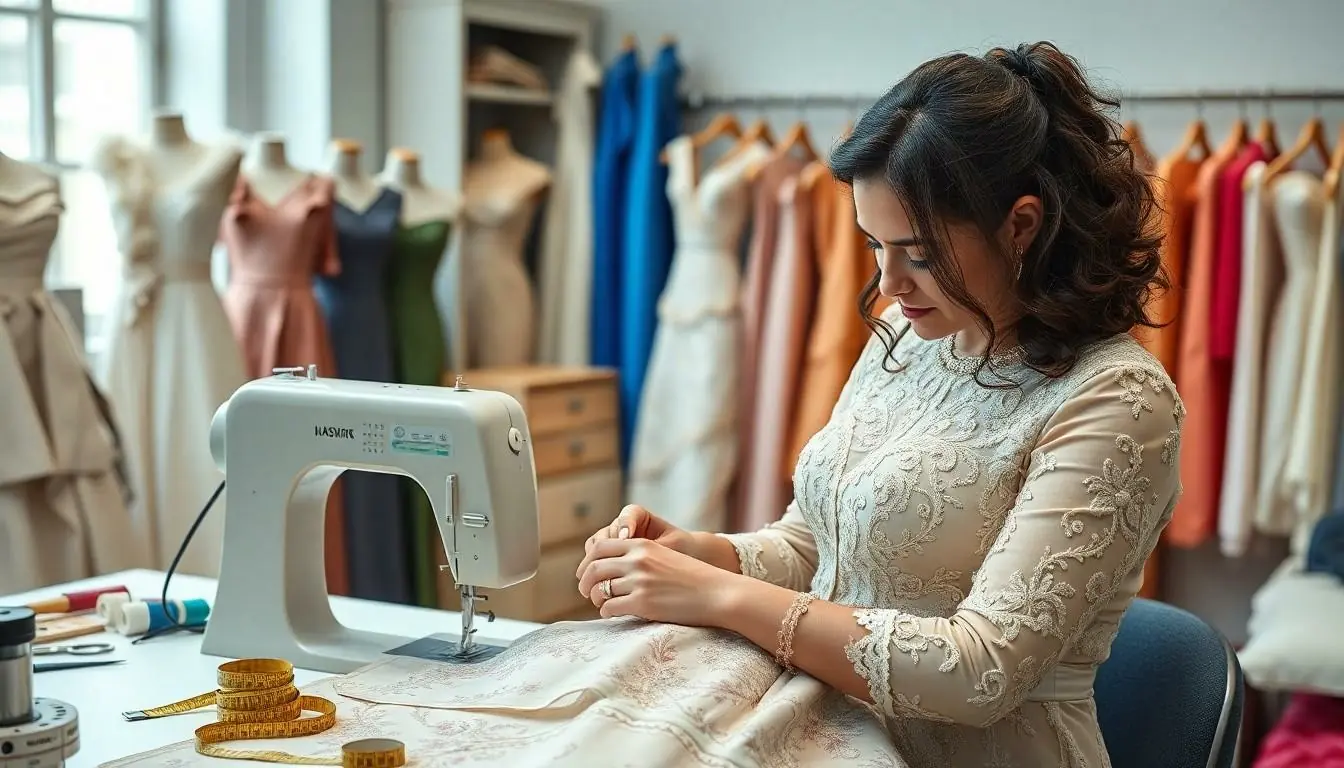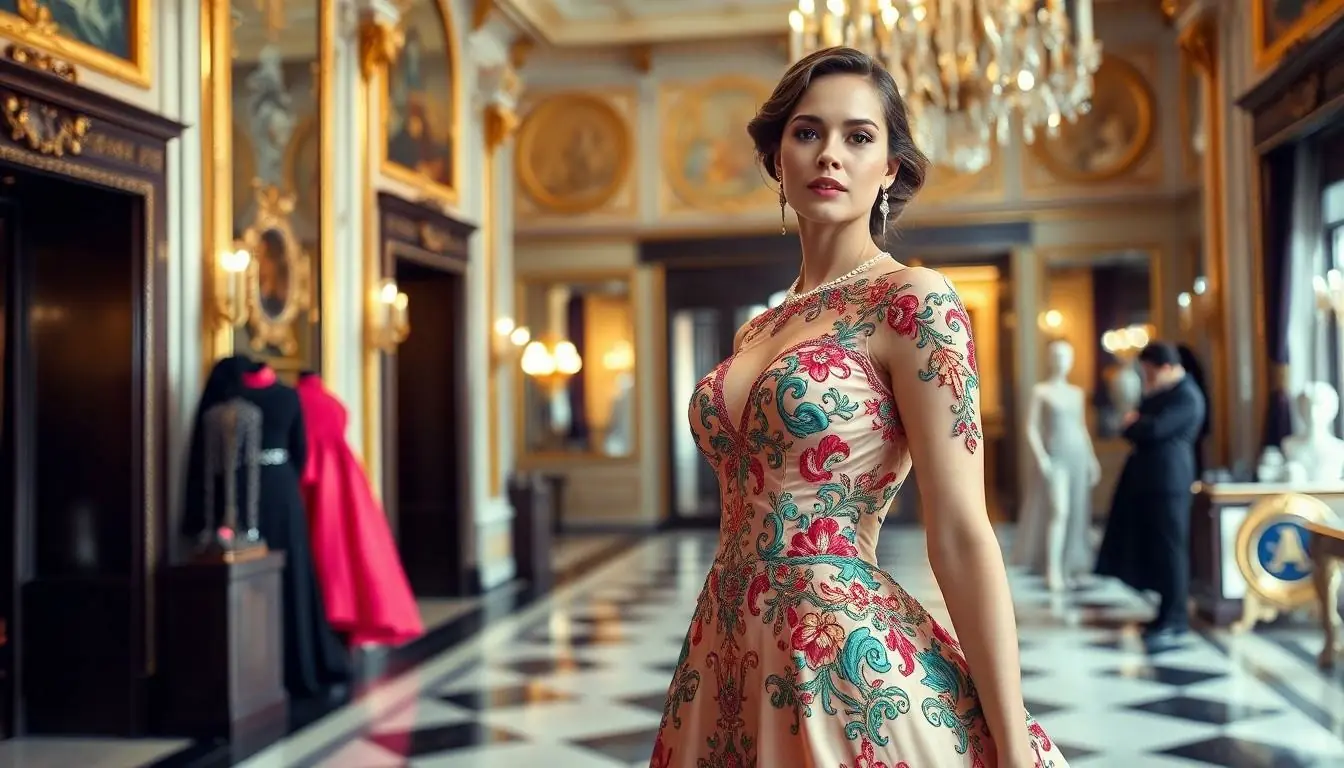Table of Contents
ToggleHaute couture isn’t just a fancy French term; it’s the pinnacle of fashion that’s as exclusive as a secret club with a velvet rope. Imagine garments so meticulously crafted that they make a Swiss watch look like a DIY project. Haute couture is where creativity meets craftsmanship, resulting in one-of-a-kind pieces that could make even the most seasoned fashionista weak at the knees.
What Is Haute Couture?
Haute couture represents the pinnacle of fashion. Exclusive in nature, it embodies meticulous artistry and individualized craftsmanship.
Historical Background
Haute couture originated in mid-19th century France. Charles Frederick Worth is recognized as the father of haute couture, establishing the first fashion house in Paris in 1858. His creations captivated elite clientele, tailoring garments to their specific measurements. The Chambre Syndicale de la Haute Couture was founded in 1868, ensuring strict regulations for haute couture houses. This organization protects the standards for originality and artistry. Over time, haute couture has evolved, integrating modern techniques while retaining traditional craftsmanship. Fashion houses such as Chanel and Dior have played pivotal roles in its advancement, making their mark in the illustrious timeline of this form.
Key Characteristics
Exclusivity stands as a hallmark of haute couture, with each piece often made for a specific client. Customization is significant; garments are tailored to an individual’s measurements and preferences. Luxurious fabrics like silk and satin are frequently employed, emphasizing quality. Creative artistry prevails through intricate embellishments and unique designs that are beyond mass production. Attention to detail defines haute couture, with skilled artisans dedicating hundreds of hours to perfect a single piece. Seasonal presentations showcase these collections, often in extravagant settings that highlight their extraordinary nature. Haute couture embodies the intersection of fashion and art, illustrating a commitment to unique beauty.
The Haute Couture Process

Haute couture involves a detailed process from conception to completion. Designers present initial sketches that often evolve through numerous iterations, ensuring every element reflects their vision. Inspiration can come from various sources, including art and nature. Upon finalizing designs, fabric selection takes center stage, emphasizing luxurious materials.
Design and Creation
The design phase involves collaboration among the designer, pattern makers, and seamstresses. Innovative techniques help transform sketches into physical garments, allowing for intricate detailing. Personal fittings allow for adjustments tailored to the client’s body, ensuring a perfect fit. Unique designs often emphasize bold silhouettes, striking colors, and engaging textures. Seasonal inspiration allows designers to push boundaries, creating collections that leave lasting impressions.
Exceptional Craftsmanship
Exceptional craftsmanship sets haute couture apart from ready-to-wear fashion. Skilled artisans dedicate hundreds of hours to each garment, focusing on intricate techniques such as hand embroidery and draping. Attention to detail is paramount; every stitch must meet the highest standards of quality. Techniques like silk painting and beading further showcase a commitment to artistry. The result is a meticulously crafted piece that embodies both elegance and individuality.
The Importance of Haute Couture
Haute couture holds a unique significance in the fashion world, intertwining artistry with cultural legacy.
Cultural Significance
Cultural influences deeply shape haute couture creations. Artists, musicians, and historical events provide inspiration for designers, creating garments that reflect societal narratives. Each piece tells a story, emphasizing personal expression and creativity. Haute couture also acts as a cultural ambassador, showcasing the craftsmanship and creativity of various trends. International fashion weeks feature these collections and celebrate diversity, uniting global communities through shared artistic vision. This blend of culture and style enhances societal appreciation for fashion.
Economic Impact
Haute couture drives significant economic activity. The industry generates billions annually, contributing to job creation in sectors such as textiles, manufacturing, and retail. Luxury fashion houses often employ hundreds of skilled artisans, sustaining local economies. Global fashion events and consumer interest boost tourism, as cities hosting couture showcases attract visitors. Investment in haute couture also supports emerging designers, fostering innovation and competition. The exclusivity and craftsmanship associated with haute couture create high-value products, underscoring its position as a vital economic force.
Haute Couture vs. Ready-to-Wear
Haute couture and ready-to-wear represent two distinct segments of the fashion industry, each with unique characteristics and offerings.
Differences in Design Philosophy
Haute couture focuses on artistic expression and exquisite craftsmanship. Designers create one-of-a-kind pieces tailored specifically for individual clients. Ready-to-wear, in contrast, emphasizes practicality and accessibility. Collections consist of standardized sizes and designs manufactured for mass market appeal. Haute couture often incorporates elaborate techniques, such as hand embroidery and intricate draping, to achieve remarkable detail. Designers of ready-to-wear prioritize functionality and ease of wear, catering to everyday consumers. This disparity in philosophy leads to varying levels of luxury and exclusivity, making haute couture rarefied yet celebrated.
Market Position
Haute couture occupies a prestigious position within the fashion landscape. It’s regarded as the pinnacle of fashion, often showcased at exclusive fashion weeks, attracting elite clients and industry influencers. In comparison, ready-to-wear holds a broader market appeal, targeting a wide range of consumers across different demographics. Prices for haute couture pieces often reach tens of thousands or even hundreds of thousands of dollars, reflecting their exclusivity and craftsmanship. Ready-to-wear offerings typically range from mid-range to luxury prices, making them accessible to a wider audience. Ultimately, the market positioning of these two segments illustrates the diverse nature of fashion consumption.
Haute couture stands as a testament to the highest level of fashion artistry and craftsmanship. Its exclusivity and meticulous attention to detail create garments that are not just clothing but masterpieces. Each piece tells a unique story shaped by cultural influences and individual preferences.
The rigorous standards upheld by the Chambre Syndicale de la Haute Couture ensure that this elite fashion segment continues to thrive. By blending creativity with exceptional skill, haute couture remains a vital force in the fashion industry. It not only showcases the pinnacle of design but also significantly impacts the economy and cultural landscape. As haute couture evolves, it will undoubtedly continue to inspire and captivate fashion enthusiasts around the world.




